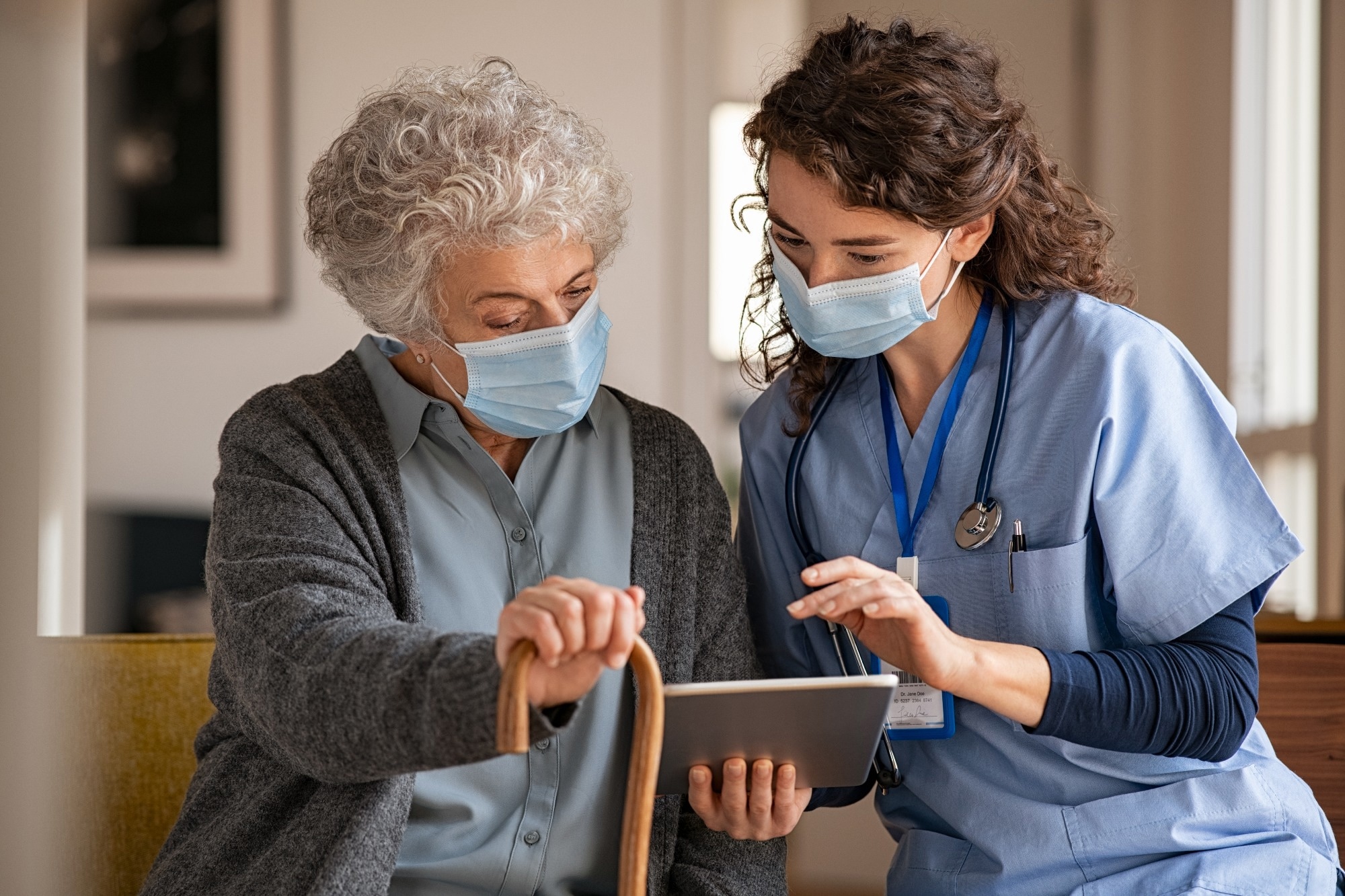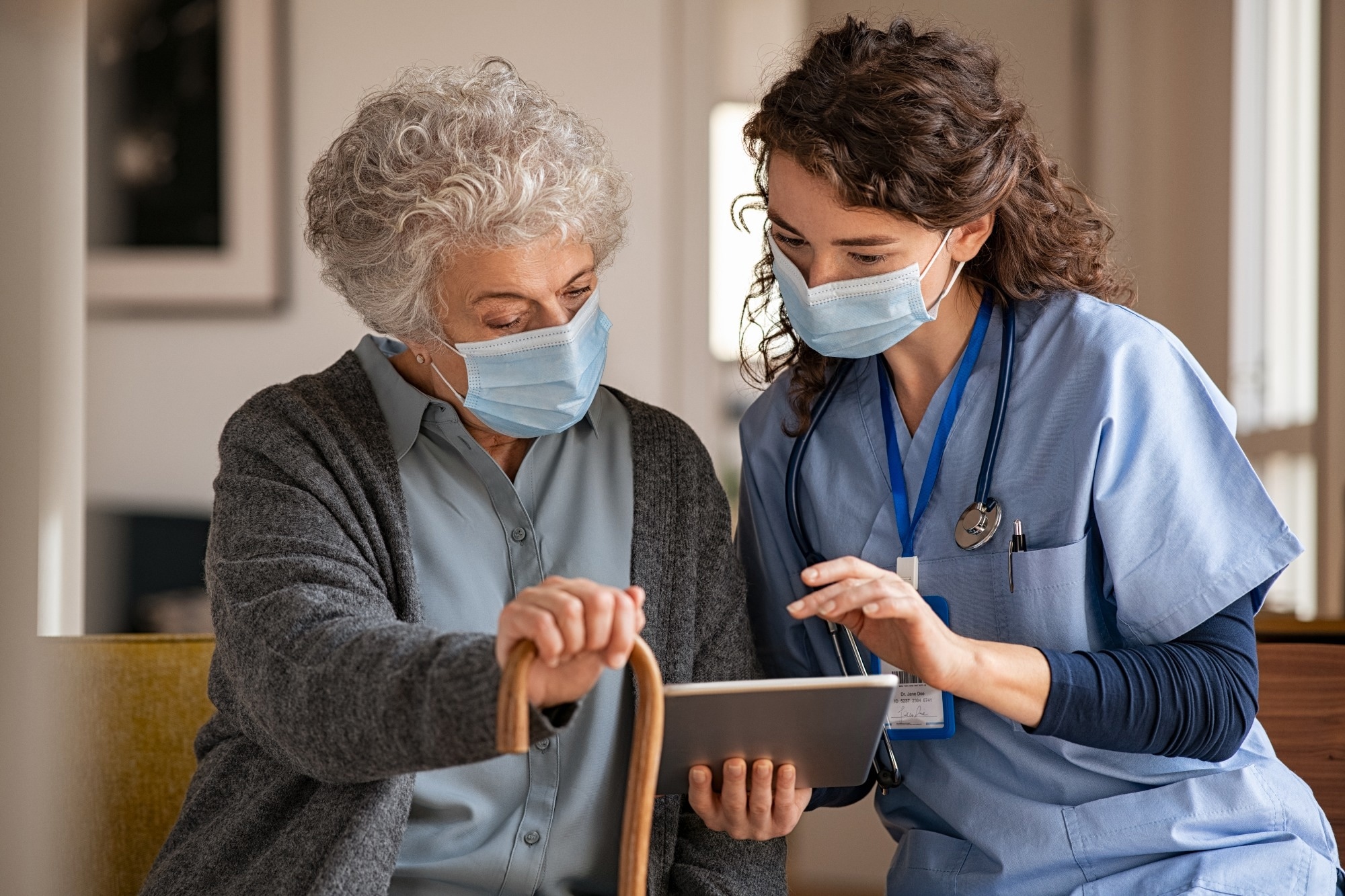In a recent study published in the Nature Aging Journal, researchers analyzed data from three SARS-CoV-2 outbreaks among nursing homes in Belgium with high case-fatality ratios (CFRs, 209 to 35%) to identify risk factors and determine the genetic signature of fatal post-coronavirus disease 2019 (COVID-19) following vaccination.
 Study: Immunovirological and environmental screening reveals actionable risk factors for fatal COVID-19 during post-vaccination nursing home outbreaks. Image Credit: Ground Picture/Shutterstock.com
Study: Immunovirological and environmental screening reveals actionable risk factors for fatal COVID-19 during post-vaccination nursing home outbreaks. Image Credit: Ground Picture/Shutterstock.com
Background
The severe acute respiratory syndrome coronavirus 2 (SARS-CoV-2) outbreak is associated with high mortality rates among nursing home residents, resulting from the effects of advanced age, frailty, comorbidities, polypharmacy, and attenuated immune function.
COVID-19 vaccines have conferred immunity to all individuals, including elderly individuals, against COVID-19 severity outcomes. However, factors that increase mortality risk following SARS-CoV-2 infections among COVID-19 vaccinees have not been extensively investigated and warrant further research.
About the study
In the present national surveillance study, researchers investigated the risk factors and genetic alterations in fatal post-vaccination COVID-19.
Quantitative polymerase chain reaction (PCR) was used to detect SARS-CoV-2 in the nasopharyngeal swabs obtained from the participants, and whole-genome sequencing (WGS) was performed to identify the causative SARS-CoV-2 variant.
In addition, phylogenetic analysis was performed to determine the genetic clade. The primary outcome was COVID-19-associated death, evaluated using the World Health Organization (WHO) criteria.
Multivariable logistic regression modeling was performed for demographic and clinical profiling of COVID-19. The mortality predictors were verified using Kaplan-Meier statistics and Cox proportional hazard regression modeling.
Further, the immunovirological profiles of nasal mucosal cells were assessed using nCounter digital transcriptomics to identify potential biomarkers for life-threatening COVID-19 following vaccination that can be targeted to develop therapeutics.
In addition, environmental aerosol sampling was performed. The findings were compared to publicly accessible RNA sequencing (RNA-seq) datasets. The nursing homes provided participants’ medical records to analyze demographic and clinical data.
All participants had received Pfizer’s BNT162b2 vaccine doses. In addition, sensitivity analyses included PCR-positive and two-dose BNT162b2 vaccinees only.
Results
The most predictive model for COVID-19-associated mortality included age, being male, interferon beta 1 (IFNB1), host angiotensin-converting enzyme 2 (ACE2), SARS-CoV-2 open reading frame 7a (ORF7a) transcripts, SARS-CoV-2 Gamma and Mu variants, and late onset of infection (SARS-CoV-2 positivity by PCR after a week of the SARS-CoV-2 outbreak).
The findings indicated that IFNB1-targeted therapies could be developed and must be initiated in the early days of infection for better outcomes.
Each SARS-CoV-2 outbreak originated from the same introduction event, albeit with different causative SARS-CoV-2 variants of concern (VOC), i.e., Gamma and Delta, and variants of interest (VOI), i.e., Mu. SARS-CoV-2 was identified among aerosol samples from spaces used by residents and staff until 52 days following the initial infection. Similar findings were observed in the sensitivity analysis.
Apart from interferon-λ2 (IFNL2) and IFNB1, genes expressed mainly by cells of the innate immune system were elevated, including those expressed by (i) macrophages and monocytes [C-X3-C motif chemokine receptor 1 (CX3CR1); tumor necrosis factor superfamily number 15 (TNFSF15); C-type lectin domain containing 6A (CLEC6A); intelectin 1; and leukocyte immunoglobulin-like receptor b5 (LILRB5)], (ii) dendritic cells [X-C motif chemokine receptor 1 (XCR1)], and (iii) natural killer cells [Thy-1 cell surface antigen (THY1); cadherin 5; the cluster of differentiation 160 (CD160); beta-1,3-glucuronyltransferase 1 (B3GAT1); the neural cell adhesion molecule 1 (NCAM1); and C-C motif chemokine ligand 3 (CCL3)].
In addition, genes of B lymphocytes [complement receptor type 2 (CR2), CD19, CD70, CD79A, CD79B, and paired box 5 (PAX5)], regulatory T lymphocytes [prostaglandin E receptor 4 (PTGER4) and forkhead box P3 (FOXP3)], and cytotoxic T lymphocytes (PTGER4 and eomesodermin) were significantly elevated in fatal COVID-19.
The findings indicated that, among older vaccinees, fatal COVID-19 is characterized by exacerbated innate and cell-mediated immunological responses. Contrastingly, major histocompatibility complex (MHC) class I activity was reduced at the functional, epigenomic, and transcriptomic levels in fatal COVID-19.
The most downregulated genes represented cells of the epithelial mucosa (CD9, polymeric immunoglobulin receptor (PIGR), and mucin-1 (MUC1), indicating SARS-CoV-2-associated damage to the epithelial mucosa.
Additionally, antisense SARS-CoV-2 was selectively increased in fatal cases, indicating heightened intracellular viral replication. Increased interferon regulatory factor 7 (IRF7) and leukocyte-associated immunoglobulin-like receptor 1 (LAIR1) expression and decreased IRF3 expression were also observed with significant enrichment of regulatory T cell (Treg) and T helper 17 cells (Th17) differentiation pathways.
The finding also indicated that interleukin-6 signaling could be a ‘downstream’ therapeutic target among IFNB1-overexpressing COVID-19 patients.
Conclusion
Overall, the study findings highlighted the risk factors and genetic alterations underlying fatal COVID-19. The results could inform drug development, contribute to risk estimation for fatal COVID-19, aid in devising tailor-made strategies, and lower the health burden of COVID-19.







